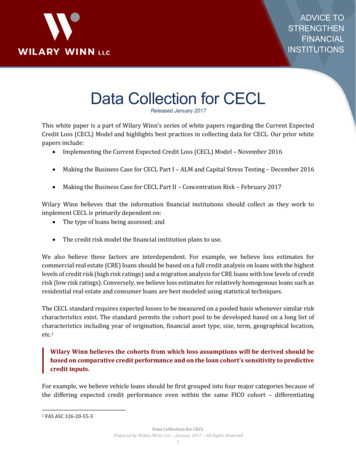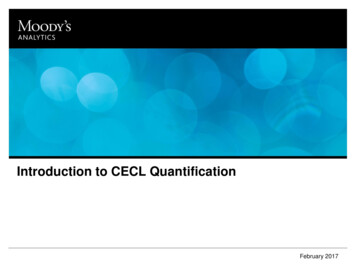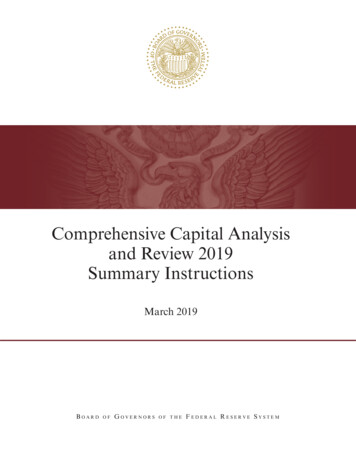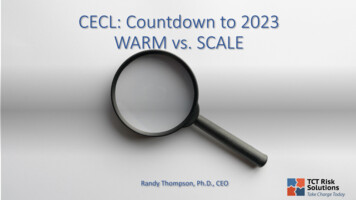
Transcription
ADVICE TOSTRENGTHENFINANCIALINSTITUTIONSData Collection for CECLReleased January 2017This white paper is a part of Wilary Winn’s series of white papers regarding the Current ExpectedCredit Loss (CECL) Model and highlights best practices in collecting data for CECL. Our prior whitepapers include: Implementing the Current Expected Credit Loss (CECL) Model – November 2016 Making the Business Case for CECL Part I – ALM and Capital Stress Testing – December 2016 Making the Business Case for CECL Part II – Concentration Risk – February 2017Wilary Winn believes that the information financial institutions should collect as they work toimplement CECL is primarily dependent on: The type of loans being assessed; and The credit risk model the financial institution plans to use.We also believe these factors are interdependent. For example, we believe loss estimates forcommercial real estate (CRE) loans should be based on a full credit analysis on loans with the highestlevels of credit risk (high risk ratings) and a migration analysis for CRE loans with low levels of creditrisk (low risk ratings). Conversely, we believe loss estimates for relatively homogenous loans such asresidential real estate and consumer loans are best modeled using statistical techniques.The CECL standard requires expected losses to be measured on a pooled basis whenever similar riskcharacteristics exist. The standard permits the cohort pool to be developed based on a long list ofcharacteristics including year of origination, financial asset type, size, term, geographical location,etc.1Wilary Winn believes the cohorts from which loss assumptions will be derived should bebased on comparative credit performance and on the loan cohort’s sensitivity to predictivecredit inputs.For example, we believe vehicle loans should be first grouped into four major categories because ofthe differing expected credit performance even within the same FICO cohort – differentiating1FAS ASC 326-20-55-5Data Collection for CECLPrepared by Wilary Winn LLC – January 2017 – All Rights Reserved1
between new and used and direct versus indirect. The table below shows the importance of choosingsub-categories as the new vehicle direct group performs 6 ½ times better than the used indirectcategory within the same FICO cohort.Collateral TypeNew Vehicle - DirectUsed Vehicle - DirectNew Vehicle - IndirectUsed Vehicle - IndirectFICOCohort660 - 719660 - 719660 - 719660 - 719CRR% CDR% Severity % Future Loss %34.78%36.95%35.48%0.04%0.08%0.22%0.26%After establishing the initial product division criteria for a homogenous loan type, we then believethese categories should be further divided into FICO bands as historical credit losses have variedsignificantly by credit score range. The table below segments the used vehicle direct category bycredit score and also shows voluntary repayment (conditional repayment rate or CRR), involuntaryrepayment (conditional default rate or CDR) and estimated loss severity. Not surprisingly, thecohorts reflecting the lowest credit score ranges also reflect the highest levels of estimated defaults.Collateral TypeUsed Vehicle - Direct Current 780 Used Vehicle - Direct Current 720 - 779Used Vehicle - Direct Current 660 - 719Used Vehicle - Direct Current 620 - 659Used Vehicle - Direct Current 500 - 619Used Vehicle - Direct Current under 500Used Vehicle - Direct Delinquent 30-59CRR%CDR%Severity 5%37.72%39.42%35.26%As an example for business lending, we believe that commercial and industrial loans should besegmented by type of business due to historical levels of credit loss variance. The following tableshows the default rates reported by the Small Business Administration (SBA) from 2007 to 2012 forcertain business types. The collateral classification for the SBA loans is determined with the NorthAmerican Industry Classification System (NAICS) code. As shown in the following table, in 2012 thedefault rate for SBA loans to bowling centers was 7.17% whereas the default rate for veterinaryservices was .41%.Data Collection for CECLPrepared by Wilary Winn LLC – January 2017 – All Rights Reserved2
SBA Default Rates by NAICS CodeEconomic VariableBowling CentersCar WashesGasoline StationsHotels and MotelsMachine ShopsOffices of DentistsOffices of LawyersVeterinary 4.043.001.321.770.660.41Wilary Winn believes that loan cohorts should be based on a financial institution’s lending strategiesand portfolio characteristics and that an institution should expend considerable effort to determinethe loan cohorts from which lifetime credit losses will ultimately be derived. For example, FinancialInstitution A could have an extensive vehicle lending portfolio with varying credit rates originatedfrom multiple sources. It would want to develop pools that appropriately reflect the risks and wouldlikely benefit by forming vehicle loan pools similarly to the process we described above. Conversely,Financial Institution B could have an insignificant vehicle loan portfolio, perhaps even aninsignificant consumer loan portfolio. It could base its pool on vehicle loans in total or even consumerloans in total. After an institution has divided its loan portfolio into cohorts, it then needs to selectthe model it will use to estimate expected credit losses. FASB and the banking regulators have madeit very clear that financial institutions can select the methodology that best suits their needs. Themost common models include loss estimates based on: Average charge-off method – the historic averages for similar loan pools (e.g. new vehicle lossrates have averaged x%) Static pool – on loan pools with similar risk characteristics originated within a similar periodof time (e.g. used indirect vehicle loans with FICOs from 720 to 780 originated within themost recent 5 years). Vintage analysis – the age of the loan and would generally include loss curves (e.g. the lossrate for a pool was .x% in year one and .y% by year two) Migration or roll-rate analyses – the likelihood of a loan moving to default (e.g. usinghistorical trends in risk rate changes to infer probable future losses)Data Collection for CECLPrepared by Wilary Winn LLC – January 2017 – All Rights Reserved3
Discounted cash flow – the loan’s contractual cash flows are adjusted for estimatedprepayments, defaults and loss severity and then discounted back to the origination date atthe note rateContinuing with our vehicle loan example, let us assume that a financial institution elects to estimatelifetime credit losses based on a vintage analysis. The example below shows the actual cumulativelosses by month since origination for a financial institution’s new vehicle direct portfolio with a 24month original term. The concept with estimating credit losses using vintage analysis is to infer thefuture loss rates by comparing performance-to-date for an origination year to historic rates of defaultwhen the past pool was of similar age. For example, one way to estimate the loss rate to be incurredof the Quarter Two 2014 vintage in its final quarter of life is take the 1.23% incurred for the quarterending at 21 months and add the average increase of .27% that historically occurred between 21months and 24 months (3.44% - 3.17%). As shown in the following table, the result is an estimatedcumulative loss rate for the final quarter of the Quarter Two 2014 vintage of 1.50%.New Vehicle - Direct - 24 month original termCumulative Loss SummaryVintageQ1 2012Q2 2012Q3 2012Q4 2012Q1 2013Q2 2013Q3 2013Q4 2013Q1 2014Q2 2014Q3 2014Q4 2014Q1 2015Q2 2015Q3 2015Q4 2015AverageActual Cumulative Losses by Months Since Origination36912151821240.00% 0.12% 0.87% 1.87% 2.03% 2.48% 2.53% 2.58%0.00% 1.30% 1.50% 3.30% 3.70% 4.70% 4.80% 4.90%0.00% 0.80% 0.81% 3.21% 6.81% 7.21% 7.31% 7.31%0.07% 1.27% 1.67% 2.53% 2.60% 3.73% 3.80% 3.87%0.04% 0.08% 0.29% 0.50% 0.54% 1.08% 1.08% 1.25%0.00% 0.30% 0.60% 0.65% 1.85% 2.50% 2.55% 2.55%0.01% 0.01% 0.06% 0.71% 1.91% 2.90% 2.91% 2.96%0.01% 0.06% 0.36% 1.01% 2.21% 3.20% 3.25% 3.30%0.00% 0.03% 0.33% 0.38% 1.03% 2.23% 2.23% 2.28%0.10% 0.11% 0.11% 0.21% 1.06% 1.18% 1.23%0.00% 0.65% 0.85% 0.90% 1.05% 1.05%0.00% 0.15% 0.33% 0.53% 1.53%0.01% 0.01% 0.02% 0.02%0.00% 0.30% 1.20%0.00% 0.25%0.00%0.01% 0.36% 0.64% 1.22% 2.19% 2.93% 3.17% 3.44%Projected Cumulative Losses by Months Since Origination36912151821240.00% 0.12% 0.87% 1.87% 2.03% 2.48% 2.53% 2.58%0.00% 1.30% 1.50% 3.30% 3.70% 4.70% 4.80% 4.90%0.00% 0.80% 0.81% 3.21% 6.81% 7.21% 7.31% 7.31%0.07% 1.27% 1.67% 2.53% 2.60% 3.73% 3.80% 3.87%0.04% 0.08% 0.29% 0.50% 0.54% 1.08% 1.08% 1.25%0.00% 0.30% 0.60% 0.65% 1.85% 2.50% 2.55% 2.55%0.01% 0.01% 0.06% 0.71% 1.91% 2.90% 2.91% 2.96%0.01% 0.06% 0.36% 1.01% 2.21% 3.20% 3.25% 3.30%0.00% 0.03% 0.33% 0.38% 1.03% 2.23% 2.23% 2.28%0.10% 0.11% 0.11% 0.21% 1.06% 1.18% 1.23% 1.50%0.00% 0.65% 0.85% 0.90% 1.05% 1.05% 1.29% 1.56%0.00% 0.15% 0.33% 0.53% 1.53% 2.27% 2.51% 2.78%0.01% 0.01% 0.02% 0.02% 1.00% 1.74% 1.97% 2.25%0.00% 0.30% 1.20% 1.77% 2.75% 3.49% 3.73% 4.00%0.00% 0.25% 0.53% 1.10% 2.08% 2.82% 3.06% 3.33%0.00% 0.35% 0.63% 1.20% 2.18% 2.92% 3.15% 3.43%0.01% 0.36% 0.63% 1.24% 2.14% 2.84% 2.96% 3.12%To implement a vintage analysis a financial institution needs to identify the total amount of loansoriginated by vintage. This total does not change and is the denominator in the loss rate calculation.We note that our example is highly simplified. We have selected a short initial loan term for ease ofpresentation. We have also selected a relatively broad loan pool – new vehicle direct regardless ofcredit grade. To fully implement this methodology a financial institution would need to accumulateloss history by year for each cohort. We strongly recommend that the loss analysis include a fulleconomic business cycle otherwise the institution will not have sufficient input if and when it facesanother economic downturn. In other words, going back only five years when building a static poolanalysis will truncate the 2008 through 2010 performance – the most recent trough in the economicData Collection for CECLPrepared by Wilary Winn LLC – January 2017 – All Rights Reserved4
cycle and an institution will therefore not have the performance statistics it needs if economicconditions are forecast to downturn similarly. In addition, we recommend that a financial institutionelecting to use this kind of analysis calculate the weighted average FICO score for each cohort toensure the credit characteristics are similar or to provide information that can be used to adjust theloss rates in the event they differ.As a firm, we have elected not to use average charge-off, static pool or vintage analyses to estimatelifetime credit losses for the following reasons: The CECL standard requires expected prepayments to be included in the estimate, adding alayer of complexity not captured with these methods – this is particularly true for residentialreal estate loans; It is very difficult to adjust these types of analyses based on only historical performance forchanges in underwriting standards; and The CECL standard requires that the loss rate adjustments be based on current andforecasted macroeconomic conditions and the historic loss rates were likely calculated basedon economic environments that are potentially quite dissimilar.We think a superior solution is to use discounted cash flow (DCF) models that are based on updatedcredit inputs. Wilary Winn believes that by first establishing detailed loan cohorts, successfullyobtaining updated predictive credit attributes, and performing a discounted cash flow analysis willlead to the most precise calculation possible of lifetime credit losses.As a reminder, discounted cash flow methods begin with the loan portfolio’s contractual cash flows,which are the adjusted using three input assumptions: Conditional repayment rate (CRR) the annual percentage rate of voluntary prepayments Conditional default rate (CDR) – the annual percentage rate of involuntary prepayments –defaults Loss severity – the loss to be incurred when a loan defaultsCRR is dependent on the loan’s interest rate compared to existing and forecasted market interestrates – does the borrower have an incentive to refinance the loan and to the loan and credit attributes– does the borrower have the ability to refinance the loan based on its existing loan-to-value ratio andthe borrower’s FICO score.CDR is dependent on the borrowers existing and forecasted FICO score and the existing andforecasted loan-to-value ratio. Loss severity is based on the loan-to-value ratio at the time of thedefault as well as foreclosure and liquidation costs.Data Collection for CECLPrepared by Wilary Winn LLC – January 2017 – All Rights Reserved5
Best practices for implementation of CECL compliant DCF models include being able to successfullyobtain updated credit information on the loan portfolio, including, but certainly not limited to: FICOfor consumer loans, FICO and combined loan-to-value amounts for residential real estate loans, andNAICS code for commercial and industrial loans.In addition to obtaining current credit attributes, an institution also needs to collect historicalperformance data. For example, if an institution elected a DCF modeling technique for its residentialreal estate closed-end second lien portfolio, we believe it would need to retrieve data on the rate ofdefault and the loss incurred on defaults by FICO and combined loan-to-value ratio by quarter overthe most recent economic business cycle. A complete list of the loan information needed to becollected to derive DCF model inputs is attached as Appendix A.Having discussed the data elements and data gathering strategy, we next address the statisticalvalidity of the historical loss data from the cohorts the financial institution elects to form. Wedemonstrated earlier in this white paper the advantages of dividing vehicle loans into four majorcomponents and further sub-dividing them by FICO score because these refinements produce farmore accurate predictions.However, the more granular and, therefore more predictive a financial institution makes apool, the fewer historical loan defaults it will contain.Wilary Winn believes few institutions by themselves have sufficient numbers of defaulted loans bymajor category – used indirect – let alone by sub-category used indirect 620-659 FICO – to bestatistically valid. We therefore believe that financial institutions will derive significant benefit bycombining their results with industry wide data. In other words, while the CECL standard requiresthe use of a financial institution’s experience and that the calculation does not require industry wideinputs, we believe implementing such a “bare bones” model would deprive an institution ofsignificant insights regarding credit performance.To repeat the example from our white paper CECL Implementation (November 28, 2016) regardingrequired pool size – we address two questions:1. How large must a pool be in order to be statistically valid?2. How do I incorporate my financial institution’s performance?How Large Must a Pool be in Order to be Statistically Valid?To help us answer the first question, we turned to Professor Edward W. Frees, the Hickman LarsonChair of Actuarial Science at the University of Wisconsin – Madison. (For the sake of relativesimplicity, we will focus on loan defaults only and omit loss given default or loss severity.) The riskof a loan defaulting is binary – it either does or does not default. In order to determine a requiredsample size a financial institution needs to determine the margin of error that it can tolerate and theData Collection for CECLPrepared by Wilary Winn LLC – January 2017 – All Rights Reserved6
amount of confidence it must have in the results2. For illustrative purposes, let us assume we cantolerate a sampling error of 3% with a 95% confidence level.Margin forError (M)ConfidenceLevel %95%RequiredSample SizeRequiredSample 0.200.400.60Proportion0.801.00As the reader can see, the required sample sizes are relatively small when the probability of defaultnears highly certain or highly uncertain (1 or 0, respectively).We can build on this idea by considering binary risks that are grouped into categories. In this nextexample, we divide loans into FICO buckets assigning default probabilities from our previousindustrywide research – loans with FICOs of 780 and above have a .03% chance of default while loanswith FICOs below 500 have a 23.06% chance of default.In statistical parlance, these differing probabilities of default are called proportions. Because we havediffering proportions, we will vary our margins of error in order to derive realistic required samplesizes.To help us determine the margins of error by FICO band, we turn the idea of financial statementmateriality. Let us say we have a financial institution with a 500 million of total assets. For the sakeof simplicity, we will assume it has 200 million of fixed rate mortgages and an allowance for loanFor readers interested in the statistical math, n equals the required sample size, pi is the probability of default, M is the𝜋(1 𝜋)tolerance level with a confidence level of 95%. The formula is n 𝓏 𝛼/22, where 𝑧𝛼/2 is a percentile from the𝑀2standard normal distribution given the required confidence level.2Data Collection for CECLPrepared by Wilary Winn LLC – January 2017 – All Rights Reserved7
losses of 0.25% or 500,000. Using a fifteen percent materiality threshold for the allowance we needto produce a loan loss estimate that is reliable to plus or minus 75,000. Let us assume an averageloss severity of 23 percent – the rate for FNMA and FHLMC prior to the most recent financialdownturn. We can then set our margin of error tolerances based on the dollar amount of loans ineach FICO bucket, the number of probable defaults, and the average loss severity.Materiality 80 720 - 779660 - 719620 - 659500 - 619under ,541,771329,957200,000,000Asset SizeFixed Rate MortgagesAverage Loan SizeNumber of Loans in PortfolioMateriality ThresholdBalance %49.70%31.60%12.34%2.93%3.27%0.16%100.00%Number of Proportion /EstimatedLoansCDR%Severity Loss 7,4988000.75%23%342,964250,000 Estimated Average Balance800 Estimated Count of Loans17,668 Required Sample SizeFailMateriality ConfidenceThreshold Level (1-a 51,7500.9574,8410.95Margin forError as aEstimated #Proportion Margin forRequired of defaulted(M/p )Error (M)Sample 31%1,2822960.16%17,66878375,000 Materiality ThresholdPassIn this case, we can see that the financial institution has an insufficient number of loans in its portfolioto be able to derive a statistically valid result. The required sample size is 17,668 loans in order forour expected credit loss estimate for the portfolio to be within 75,000 and the financial institutionhas just 800 loans. As a result, it will need to rely on information derived from larger pools. We canalso see that our example financial institution does not have sufficient information in the lower riskFICO groupings – the areas with the greatest potential risk. For example, to be statistically accuratea financial institution would need 3,700 loans in the 660-719 group for which we would expect 24defaults. Our sample financial institution has just 99 loans in this cohort. We believe that this datashortfall for lower quality loans will continue as we continue to move forward into the future fromthe financial downturn. Nevertheless, we want to incorporate the financial institution’s actualperformance into our loss estimates.This reinforces the need for larger data pools because slicing the groupings again obviously resultsin fewer loans per predictive indicator.How Do I Incorporate My Financial Institution’s Performance?To help us with the second question of incorporating a financial institution’s actual results, we againturned to Professor Frees and we can learn from another industry. The insurance industry addressesthe issue with a concept called “credibility theory”. The idea is to blend a financial institution’s lossrates with industry-wide loss experience. There are many varieties of credibility theory that can beused depending on company expertise and data availability. One variety is "Bayesian credibilityData Collection for CECLPrepared by Wilary Winn LLC – January 2017 – All Rights Reserved8
theory" that employs statistical Bayesian concepts in order to utilize a company’s understanding ofits business and its own experience.We will use the 500-619 FICO group for our example. Assuming the average loan size for this cohortis also 250,000, we have 26 loans in the group. To estimate our sample size, we used an industryaverage default rate of 13.73% for the group and our required sample size was 2,673 loans. Weassume that 367 of the 2,673 loans in the group will default. To continue our example, let us assumethat the financial institution’s actual recent default experience was 49.68% for this FICO cohort.While it first appears that the financial institution’s default probability is worse than the industryaverage, this could also be due to chance variability. To avoid this potential outcome, we want toincorporate the financial institution’s actual performance into our CDR estimate in a statistically validway. To do this, we want to be 95% confident that our estimate is within 9.5% of the true defaultprobability, consistent with our required sample size inputs.Credibility estimators take on the form:New Estimator Z Company Estimator (1 Z) Prior (Industry) EstimatorAlthough there are many variations of this estimator, most experts express the credibility factor inthe form:Z n/(n k)for some quantity k and company sample size n. The idea is that as the company sample size nbecomes larger, the credibility factor becomes closer to 1 and so the company estimator becomes animportant in determining the final “new estimator.” In contrast, if the company has only a smallsample n, then the credibility factor is close to 0 and the external information is the more relevantdeterminant of the final “new estimator.”For our example, using some standard statistical assumptions, one can show that:k 4/(L 2 * Prior Estimator)Here, "L" is the proportion desired (9.5% in our example, margin for error as a proportion or M/π inour prior example notation). Our prior estimate for defaults (“CDR” or proportion) for this band was13.73%.To continue, this is k 4/(L 2 * Prior Estimator) 4/(9.5 2 * 0.1373) 3,228. With this, we have thecredibility factor Z 26/(26 3,228) 0.80%Our final CDR estimate for the 500 to 619 FICO band is equal to our company input (49.68% * 0.80%) (1 – 0.80%) * 13.73% or 14.02%. We have thus incorporated the financial institution’s performanceData Collection for CECLPrepared by Wilary Winn LLC – January 2017 – All Rights Reserved9
in this loan category into our CDR estimate in a statistically valid way deriving a lower estimate thanhad we used the institution’s actual results only.As clearly demonstrated with the insights obtained from the work of Professor Frees, Wilary Winnbelieves that industry default data is needed as a supplement to a financial institution’s own internalcredit loss experience to establish a CECL process that is accurate with respect to predicting futurelifetime losses at the cohort level. This type of loss estimate analysis best lends itself to the discountedcash flow method.Macroeconomic InputsThe CECL standard requires that the lifetime loss estimate be based on current and forecastedeconomic conditions. Regardless of the technique selected, we believe a financial institution shouldidentify the sources it will use for historical analysis and for forecasted changes in macroeconomicconditions. This is more complex than it seems. For example, most would agree that the best sourcefor the historic rates of unemployment is the Bureau of Labor Statistics. However, should aninstitution collect data at the state level, the county level, the MSA level, etc. We believe this dependson the financial institution’s concentration of loans by geographic area. As another example, shouldan analysis of changes in housing prices be based on data from the Federal Housing Finance Agency,Case Shiller or another source. Even more subtly, which data set within the FHFA data should afinancial institution use – all transactions, purchase only transactions, seasonally or non-seasonallyadjusted, etc. We use the seasonally adjusted, purchase-only HPI.Identifying sources for future macroeconomic conditions can be even more challenging and webelieve this could be the most challenging aspect of implementation because the standard requires“reasonable and supportable” forecasts. Continuing our residential real estate loan example, we useCase Shiller forecasts for the near term and revert to the Zillow national forecast over the long term.Advantages of Using Discounted Cash Flow ModelsWilary Winn believes the discounted cash flow model approach to CECL estimates providesnumerous advantages over the alternative loss measures such as vintage analysis or average chargeoff method. More specifically:1. DCF models are widely used across the financial services industry and the Securities Industryand Financial Markets Association (“SIFMA”) has standardized the mathematicalcalculations. As a result, users do not have to come to agreement on the financial mathematics– e.g. how to calculate single month mortality – they can focus on how the model inputassumptions were derived.2. DCF models explicitly include a methodology to account for voluntary prepayments, whichmust be considered as part of a CECL calculation.Data Collection for CECLPrepared by Wilary Winn LLC – January 2017 – All Rights Reserved10
3. DCF models are prospective in nature and changes in expected macroeconomic conditionscan be relatively easily incorporated into them. Wilary Winn begins with future expectedcontractual cash flows and modifies our model input assumptions based on macroeconomicforecasts. For example, Wilary Winn’s default rate assumptions for consumer and residentialreal estate loans are based on the existing and forecasted unemployment rate and we caneasily incorporate expected changes in the unemployment rate into our models. Similarly,our loss severity assumption for residential real estate loans is based on the combined loanto-value ratio of the loan. Our DCF models dynamically vector the combined LTV based onexpected changes in housing prices. We believe this is much more straightforward and, thusmore easily verified, than making environmental and qualitative adjustments to say a vintageanalysis.4. We believe that because very few financial institutions will have a statistically valid sampleof loan defaults at the cohort level, incorporating industry default data will be of criticalimportance to accurately forecast lifetime credit losses. Wilary Winn believes that thecredibility theory approach in which industry performance data is included with a financialinstitution’s own loss experience (described previously in this white paper) is most easilyaccomplished with the discounted cash flow method by modifying the primary inputassumptions CRR, CDR and loss severity.5. Wilary Winn believes that by segmenting the loan portfolio into predictive credit cohorts andthen using FICO, combined loan-to-value ratios and credit risk rating to derive defaultassumptions can lead to better communication across the organization. For example, webelieve it is much simpler to discuss FICO and combined LTV attributes for a used indirectvehicle loan portfolio with a financial institution’s lenders than it is to share the results of avintage analysis adjusted for environmental and qualitative factors because FICO and LTV arekey inputs that the lenders use to make credit decisions. The finance department is essentiallyspeaking their language rather than discussing a high level retrospective analysis that hasbeen adjusted top down to derive prospective forecasts.6. We believe that dynamic, prospective DCF models based on the credit attributes aninstitution’s lenders use to make loans can lead to better allocations of capital. See our whitepapers Making the Business Case for CECL Part I – which addresses capital stress testing andMaking the Business Case for CECL – Part II – which addresses concentration riskmanagement. Finally, look for our Part III segment which will focus on lifetime credit lossesand loan pricing – real return analysis.ConclusionWilary Winn believes that the information financial institutions should collect as they work toimplement CECL is primarily dependent on: The type of loans being assessed The credit risk model the financial institution plans to useData Collection for CECLPrepared by Wilary Winn LLC – January 2017 – All Rights Reserved11
We also believe these factors are interdependent as we have shown in this white paper. We furtherbelieve that while the CECL standard permits the use of numerous methodologies for determininglifetime credit loss exposure, that the use of dynamic, prospective discounted cash flow models of
Static pool - on loan pools with similar risk characteristics originated within a similar period of time (e.g. used indirect vehicle loans with FICOs from 720 to 780 originated within the most recent 5 years). Vintage analysis - the age of the loan and would generally include loss curves (e.g. the loss










